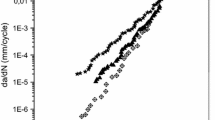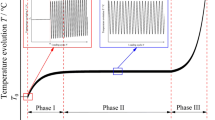Abstract
This paper presents an experimental study of energy dissipation caused by fatigue crack growth in Grade 2 titanium and titanium alloys Ti-1.1Al-0.9Mn and Ti-4.6Al-1.77V using the original heat flux method. It is shown that significant structural changes occur in the material under plastic deformation, leading to internal energy evolution. As is known, a large part of the deformation energy is dissipated as heat. The developed method allows high-accuracy measurements of the heat flux caused by plastic zone development at the crack tip directly in the fatigue experiment. Simultaneous measurements of the crack length and displacements in the stress concentration zone allow estimating the energy balance of the tested specimens. Analysis of the obtained data confirms that the stored strain energy reflecting the structural state of the material can be used as a fracture criterion. Based on the heat flux data, a kinetic equation is derived for predicting the rate of fatigue crack growth under Paris’s law by the energy dissipation rate.





Similar content being viewed by others
REFERENCES
Paris, P.C. and Erdogan, F.J., A Critical Analysis of Crack Propagation Laws, J. Basic Eng. Trans ASME, 1963, vol. 85, pp. 528–534. https://doi.org/10.1115/1.3656900
Jones, R., Molent, L., and Pitt, S., Similitude and the Paris Crack Growth Law, Int. J. Fatigue, 2008, vol. 30, pp. 1873–1880. https://doi.org/10.1016/j.ijfatigue.2008.01.016
Iino, Y., Fatigue Crack Propagation Work Coefficient—A Material Constant Giving Degree of Resistance to Fatigue Crack Growth, Eng. Fract. Mech., 1979, vol. 12, pp. 279–299. https://doi.org/10.1016/0013-7944(79)90120-6
Fedorov, V.V., Kinetics of Damage and Fracture of Solids, Tashkent: Fan, 1985.
Ivanova, V.S. and Terentyev, V.F., Nature of Metal Fatigue, Moscow: Metallurgiya, 1975.
Kasimov, B.M., Muminov, M.R., and Shin, I.G., Determination of Latent Strain Energy Based on Thermodynamic Relationships during Finishing and Strengthening Treatment, in Proc. of the 54th International Scientific and Technical Conference of Teachers and Students, 2 vols., Vitebsk: Educational Institution VSTU, 2021, pp. 283–285.
Shchipachev, A.M., Thermodynamic Theory of Strength: Prediction of High-Cycle Fatigue of Metals, Ufa: Ufa Technological Institute of Service, 1998.
Arutyunyan, A.R. and Arutyunyan, R.A., Fatigue Criterion Based on the Concept of Latent Strain Energy, Fiz. Mezomekh., 2010, vol. 13, no. 2, pp. 31–39.
Arutyunyan, A.R. and Arutyunyan, R.A., Energy Approach to the Solution of the High-Cycle Fatigue Problem, Vest. Nizhegorod. Univer. Lobachevskogo, 2011, no. 4-4, pp. 1359–1360.
Structural Levels of Plastic Deformation and Fracture, Panin, V.E., Ed., Novosibirsk: Nauka, 1990.
Shchipachev, A.M. and Poyarkova, E.V., Influence of Fatigue Damage on Hardness and Internal Energy Storage in Metals, Mashinostr. Materialoved. Termich. Obrab. Met., 2007, vol. 9, no. 6(24), pp. 152–157.
Bezyazychnii, V.F., Drapkin, B.M., Prokofiev, M.A., and Timofeev, M.V., Study of Strain Energy Stored in Metal during Ball Indentation, Zavod. Lab., 2005, vol. 71, no. 4, pp. 32–35.
Bolshanina, M.A. and Panin, V.E., Latent Strain Energy, in Research in Solid State Physics, Moscow: Publ. House of the USSR Academy of Sciences, 1957, pp. 193–234.
Bever, M.B., Holt, D.L., and Titchener, A.L., The Stored Energy of Cold Work, Progr. Mater. Sci., 1973, vol. 17, pp. 5–177. https://doi.org/10.1016/0079-6425(73)90001-7
Mason, J.J., Rosakis, A.J., and Ravichandran, G., On the Strain and Strain Rate Dependence of the Fraction of Plastic Work Converted to Heat: An Experimental Study Using High Speed Infrared Detectors and the Kolsky Bar, Mech. Mater., 1994, vol. 17, no. 2–3, pp. 135–145. https://doi.org/10.1016/0167-6636(94)90054-X
Rittel, D., On the Conversion of Plastic Work to Heat during High Strain Rate Deformation of Glassy Polymers, Mech. Mater., 1999, vol. 31, no. 2, pp. 131–139. https://doi.org/10.1016/S0167-6636(98)00063-5
Hodowany, J., Ravichandran, G., Rosakis, A.J., and Rosakis, P., Partition of Plastic Work into Heat and Stored Energy in Metals, Exp. Mech., 2000, vol. 40, no. 2, pp. 113–123. https://doi.org/10.1007/BF02325036
Rittel, D., Zhang, L.H., and Osovski, S., The Dependence of the Taylor–Quinney Coefficient on the Dynamic Loading Mode, J. Mech. Phys. Solids, 2017, vol. 107, pp. 96–114. https://doi.org/10.1016/j.jmps.2017.06.016
Neto, D.M., Simões, V.M., Oliveira, M.C., Alves, J.L., Laurent, H., Oudriss, A., and Menezes, L.F., Experimental and Numerical Analysis of the Heat Generated by Plastic Deformation in Quasi-Static Uniaxial Tensile Tests, Mech. Mater., 2020, vol. 146, p. 103398. https://doi.org/10.1016/j.mechmat.2020.103398
Plekhov, O.A., Energy Dissipation and Storage during Plastic Deformation and Fracture of Metals (Experimental and Theoretical Research), in Proc. of XII All-Russian Congress on Fundamental Problems of Theoretical and Applied Mechanics, Ufa, August 19–24, 2019, 4 vols., Ufa: Bashkir State University, 2019, vol. 3, pp. 32–35.
Taylor, G.I. and Quinney, H., The Latent Energy Remaining in a Metal after Cold Working, Proc. R. Soc. Lond., 1934, pp. 307–326. https://doi.org/10.1098/rspa.1934.0004
Dæhli, L.E.B., Johnsen, J., Berstad, T., Børvik, T., and Hopperstad, O.S., An Experimental-Numerical Study on the Evolution of the Taylor–Quinney Coefficient with Plastic Deformation in Metals, Mech. Mater., 2023, vol. 179, p. 104605. https://doi.org/10.1016/j.mechmat.2023.104605
Kostina, A.A., Plekhov, O.A., and Venkatraman, B., Use of Stored Strain Energy in Numerical Modeling of Fracture of Steel Structures, Vestn. Samar. Gos. Univer. Ser. Fiz.-Mat. Nauk, 2016, vol. 20, no. 4, pp. 656–674. http://dx.doi.org/10.14498/vsgtu1518
Chudnovsky, A. and Moet, A., Thermodynamics of Translational Crack Layer Propagation, J. Mater. Sci., 1985, vol. 20, pp. 630–635.
Wang, X.G., Ran, H.R., Jiang, C., and Fang, Q.H., An Energy Dissipation-Based Fatigue Crack Growth Model, Int. J. Fatigue, 2018, vol. 114, pp. 167–176. https://doi.org/10.1016/j.ijfatigue.2018.05.018
Vshivkov, A., Iziumova, A., Zakharov, A., Shlyannikov, V., and Plekhov, O., The Experimental and Theoretical Study of Heat Dissipation at Fatigue Crack Tip under Biaxial Loading, Theor. Appl. Fract. Mech., 2019, vol. 103, p. 102308. https://doi.org/10.1016/j.tafmec.2019.102308
Vshivkov, A.N., Iziumova, A.Yu., Panteleev, I.A., Ilinykh, A.V., Wildemann, V.E., and Plekhov, O.A., The Study of a Fatigue Crack Propagation in Titanium Grade 2 Using Analysis of Energy Dissipation and Acoustic Emission Data, Eng. Fract. Mech., 2019, vol. 210, pp. 312–319. https://doi.org/10.1016/j.engfracmech.2018.05.012
Kozhevnikova, M.E., An Analytical Approach to the Evaluation of Energy Dissipation at the Fatigue Crack Tip, Fiz. Mezomekh., 2020, vol. 23, no. 3, pp. 93–106. https://doi.org/10.24411/1683-805X-2020-13009
Meneghetti, G. and Ricotta, M., A Heat Energy Dissipation Approach to Elastic-Plastic Fatigue Crack Propagation, Theor. Appl. Fract. Mech., 2020, vol. 105, p. 102405. https://doi.org/10.1016/j.tafmec.2019.102405
Quan, H. and Alderliesten, R.C., The energy dissipation during fatigue crack growth in metallic materials, Eng. Fract. Mech., 2022, vol. 269, p. 108567. https://doi.org/10.1016/j.engfracmech.2022.108567
Vshivkov, A.N., Prokhorov, A.E., Plekhov, O.A., Ber, J., and Batsal, Zh.-K., Patent 2603939 RF, IPC G01N 3/32 (2006.01), Method for Determining Crack Growth Rate in the Sample and Device for Its Implementation, Byul. FSIS (Rospatent), 2016, no. 34. https://new.fips.ru/Archive/PAT/2016FULL/2016.12.10/Index_ru.htm
Illarionov, A.G. and Popov, A.A., Technological and Operational Properties of Titanium Alloys: Textbook, Yekaterinburg: Ural Univ. Publ. House, 2014. https://elar.urfu.ru/bitstream/10995/28698/1/978-5-7996-1096-8_2014.pdf
Moiseev, V.N., Titanium in Russia, Met Sci. Heat Treat., 2005, no. 8. https://viam.ru/sites/default/files/scipub/2005/2005-204293.pdf
Vshivkov, A., Iziumova, A., and Plekhov, O., Experimental Study of Heat Dissipation at the Crack Tip during Fatigue Crack Propagation, Fratt. Integr. Strutt., 2016, vol. 35, pp. 131–137. https://doi.org/10.3221/IGF-ESIS.35.16
Gachegova, E.A., Sikhamov, R., Ventzke, V., Kashaev, N., and Plekhov, O.A., Influence of Laser Shock Peening on Low- and High-Cycle Fatigue of an OT4-0 Titanium Alloy, J. Appl. Mech. Tech. Phys., 2022, vol. 63, no. 2, pp. 335–342.
Pavlenko, D.V., Tkach, D.V., and Greshta, V.L., Deformation Behavior and Endurance of VT1-0 Alloy with a Submicrocrystalline Structure, Vest. Dvigatelestr., 2011, no. 1, pp. 125–131.
Naidenkin, E.V., Kolomeets, N.P., Ratochka, I.V., Kaminskii, P.P., and Sharkeev, Yu.P., PT-3V Titanium Alloy with Ultradisperse Structure for Waveguides of High-Amplitude Acoustic Systems, Vopr. Materialoved., 2009, no. 4, pp. 15–19.
Rice, J.R., Mechanics of Crack Tip Deformation and Extension by Fatigue, ASTM. Spec. Tech. Publ., 1966, vol. 415, pp. 247–311. https://doi.org/10.1520/STP47234S
Klevtsov, G.V., Plastic Zone Patterns Formed at the Crack Tip under Various Loading and X-Ray Diagnostics of Fracture, Vest. Orenburgsk. Gos. Univ., 2006, vol. 2, no. 1, pp. 81–88.
Klevtsov, G.V., Botvina, L.R., Klevtsova, N.A., and Limar, L.V., Diagnostics of Fracture of Metal Materials and Structures, Moscow: MISiS, 2007.
Klevtsov, G.V., Botvina, L.R., Klevtsova, N.A., Valiev, R.Z., and Pigaleva, I.N., Determination of Fatigue Failure Parameters from the Depth of Plastic Zones Beneath the Fracture Surface, Phys. Mesomech., 2023, vol. 26, no. 1, pp. 1–6. https://doi.org/10.1134/S1029959923010010
Raju, K.N., An Energy Balance Criterion for Crack Growth under Fatigue Loading from Considerations of Energy of Plastic Deformation, Int. J. Fract. Mech., 1972, vol. 8, pp. 1–14.
Vshivkov, A., Iziumova, A., Yarullin, R., Shlyannikov, V., and Plekhov, O., Experimental and Theoretical Analysis of Heat Flux at Fatigue Crack Tip under Mixed Mode Loading, Proc. Struct. Integr., 2019, vol. 18, pp. 608–615. https://doi.org/10.1016/j.prostr.2019.08.206
Funding
The experimental part of the work was supported by Russian Science Foundation grant No. 22-79-10168. Data analysis and estimation of stored energy were carried out within the government statement of work for the Institute of Continuous Media Mechanics UB RAS, a branch of the Perm Federal Research Center UB RAS (research line AAAA-A19-119013090021-5).
Author information
Authors and Affiliations
Corresponding author
Ethics declarations
The authors of this work declare that they have no conflicts of interest.
Additional information
Publisher's Note. Pleiades Publishing remains neutral with regard to jurisdictional claims in published maps and institutional affiliations.
Rights and permissions
About this article
Cite this article
Iziumova, A.Y., Vshivkov, A.N. & Plekhov, O.A. Development of an Energy-Based Experimental Method for Estimation of Fatigue Crack Evolution in Titanium Alloys. Phys Mesomech 27, 41–48 (2024). https://doi.org/10.1134/S1029959924010041
Received:
Revised:
Accepted:
Published:
Issue Date:
DOI: https://doi.org/10.1134/S1029959924010041




